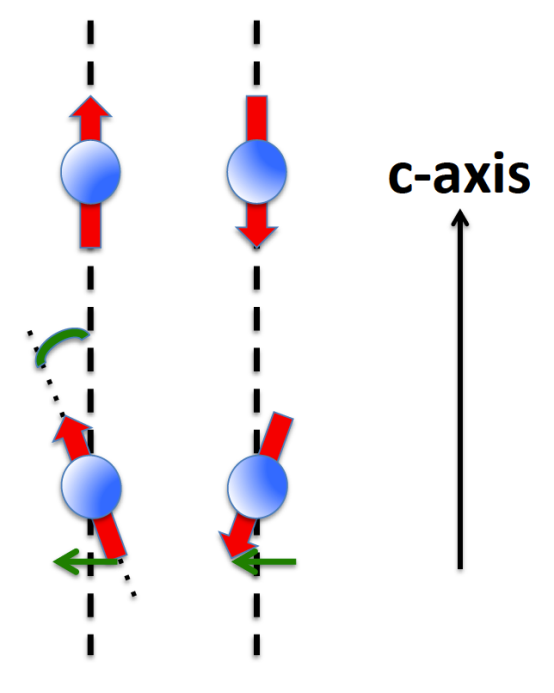Apr 6 2020
Materials that integrate quantum magnetism and topological electronic properties have presently attracted a great deal of interest, specifically for the quantum many-body physics that are likely to unfold in them and also for potential applications in electronic components.
 Antiferromagnetic (top) and canted-antiferromagnetic order (bottom). In the latter case, the spins are canted relative to the easy c-axis, leading to a ferromagnetic contribution in the plane orthogonal to that axis (represented by green arrows). Image Credit: ETH Zurich Department of Physics.
Antiferromagnetic (top) and canted-antiferromagnetic order (bottom). In the latter case, the spins are canted relative to the easy c-axis, leading to a ferromagnetic contribution in the plane orthogonal to that axis (represented by green arrows). Image Credit: ETH Zurich Department of Physics.
Physicists at ETH Zurich have currently established a microscopic mechanism for one such material, connecting magnetism and electronic-band topology.
Dirac matter is an interesting group of materials that have rather unusual properties: electrons act as if they lack mass in these materials. While graphene is considered as the most conspicuous Dirac material, more members have been identified in the past 15 years or so.
Each one of these members acts as a rich playground for analyzing “exotic” electronic behaviors, with some of them holding the potential to allow innovative components for electronics.
But even if Dirac matter as well as other so-called topological materials, where electrons act in analogously surprising ways, are among today’s most intensively researched condensed-matter systems, only very few examples exist where the electronic bands’ topology is linked in a well-defined way to the materials’ magnetic properties.
CaMnBi2 is one such material where the interplay between magnetism and topological electronic states has been noticed. However, the mechanism that connects the two continues to be vague.
Writing in the Physical Review Letters journal, Run Yang, a postdoc, and Matteo Corasaniti, PhD student from the Optical Spectroscopy group of Professor Leonardo Degiorgi at the Laboratory for Solid State Physics, in association with collaborators at the Chinese Academy of Sciences in Beijing and Brookhaven National Laboratory (United Stated) have recently reported an exhaustive analysis in which they offer a distinct proof that it is a mild nudge on the magnetic moments, called spin canting, that causes considerable variations in the electronic band structure.
Compass Points to the Right Direction on a Bumpy Road
CaMnBi2 and its associated compound SrMnBi2 have now garnered interest since they exhibit quantum magnetism—at about room temperature and below, the manganese ions in these compounds are antiferromagnetically ordered—and they also host Dirac electrons simultaneously.
The fact that an interaction occurs between the two characteristics has long been assumed for some time, and equally significant is that an unanticipated “bump” occurs in the conduction properties of these materials at approximately 50 K. However, the accurate nature of this anomaly was not been understood very well, until now.
In previous studies exploring CaMnBi2’s optical properties, Corasaniti, Yang, and colleagues had already established a connection to the material’s electronic characteristics. Specifically, the researchers exploited the fact that the bump-like anomaly that is seen in the transport properties can be changed in temperature by substituting a fraction of the calcium atoms with sodium atoms.
To figure out the minute origins of the observed behavior, the researchers analyzed samples with varying sodium dopings through torque magnetometry. In this method, the torque on a magnetic sample is quantified upon exposing the sample to an appropriately powerful field, just like how a compass needle aligns with the magnetic field of Earth. This method proved to point the researchers to the origins of the anomaly.
A Firm Link Between Magnetic and Electronic Properties
The scientists performed magnetic-torque experiments, in which they discovered that at temperatures where the electronic transport measurements do not show any kind of anomaly, the magnetic behavior is just as similar to one would anticipate for an antiferromagnet.
But this was no longer the case at lower temperatures, where the anomaly exists. Here, a ferromagnetic component emerged that can be elucidated by a projection of magnetic moments onto the plane orthogonal to the easy spin c-axis of the initial antiferromagnetic order. Such a phenomenon is called spin-canting and is caused by a so-called super-exchange mechanism.
Both sets of experiments—that is, torque and optical measurements—were supported by specialized first-principles calculations. Specifically, for the case where spin canting was considered in the calculations, a strange hybridization between the bismuth and manganese atoms was found to regulate the interlayer magnetic coupling and to control the material’s electronic properties.
Collectively, the research thus shows that sought-after direct association between the changes to the electronic band structure and magnetic properties, indeed reflected in the transport properties’ bump anomaly.
With such a comprehensive understanding on board, the study paves the way for studying the CaMnBi2’s electronic properties and the associated compounds, and it also offers the possibilities that emerge from the link between topological states and magnetic properties in these fascinating forms of matter.